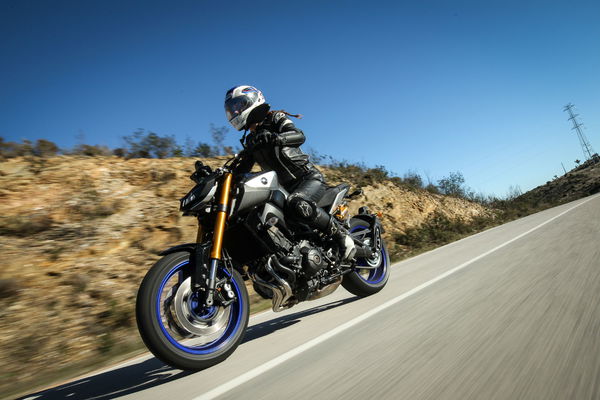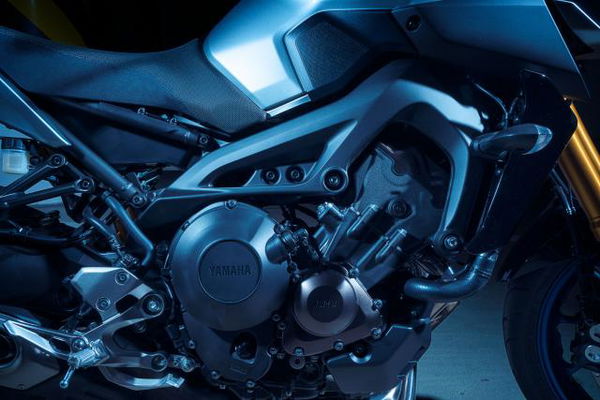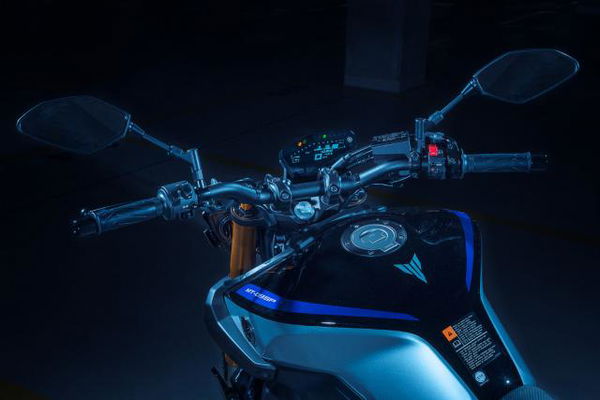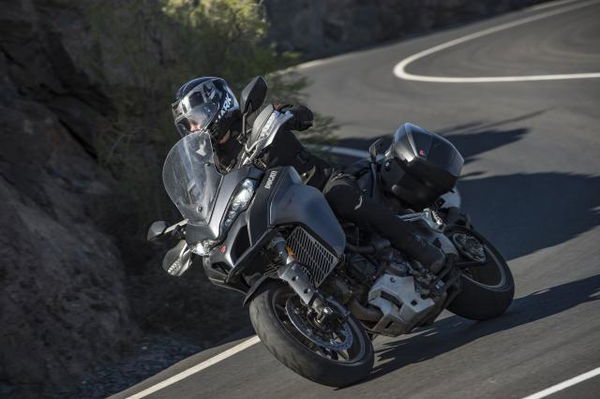First ride: Yamaha MT-09 SP review
Get the SP experience for less than £9,000

DESPITE being but in its infancy, Yamaha’s MT range is a guaranteed future icon.
I’m not talking about the flops that were the noughties MT-01 and MT-03, instead I’m referring to the aggressively styled, post-2013 hyper naked machines.
In just four years – since the first MT-09 launched in September 2013 – the Japanese manufacturer has shifted more than 140,000 MT models in Europe alone.
The 07 is by far the most popular, with almost 70,000 sold since it hit the market in 2014. Then it’s the 09, with 37,810 units sold in total. Not a mile behind is the MT-125 at 24,117, while the A2 compliant MT-03, launched in 2016, has sold almost 2,400.
The MT-10, first seen at EICMA 2015 and launched the year later, has made for 6,255 very happy bikers, and its potent twin – the MT-10 SP –1,526.
It’s the latter model, born of a marriage between the MT-10 and the YZF-R1M that served as inspiration for the MT-09 SP that I rode in Faro, Portugal, earlier this week.
Yamaha’s reason for adding the R1M colour scheme, performance-orientated parts and the ‘SP’ badge to the MT-09 is simple: appeal to a different audience and shift more units.
By ‘different audience’, read ‘audience wanting the performance-orientated ride for less.’ Costing from £8,999, the MT-09 SP is a whopping £5,000 less than its bigger brother.
However, this cost cut comes at a price. While the MT-10 SP boasts Öhlins active suspension front and rear (not to forget that excellent, R1-derived four cylinder crossplane crank engine of the MT-10) the MT-09 SP only gets mechanically adjustable Öhlins at the rear, and an adjustable KYB fork up front.
Nonetheless, it’s still unmistakeably SPecial, and it looks the part too, thanks to a new compact design.

Engine:
The 847cc three-cylinder crossplane engine has always been the strongest point of the standard MT-09.
With plentiful power, linear torque and a raw character, it has stood the test of time and only seen minor updates since the model’s introduction.
Now made Euro4-compliant, it hasn’t lost its charm or potency and, making 114hp and 64.5 ft-lb of torque at 8,500 revs, serves as an excellent base for the SP badge.
With the MT-09’s most recent update last year came an R1-derived quickshifter, allowing the rider to really make the most out of the potent triple.
As the revs climb towards the 11,300rpm redline, kick the lever up to maintain relatively smooth acceleration, without closing the throttle. Similarly, allow the revs to drop before shifting down for the ultimate ease of use.
A slip and assist clutch also featured on the 2017 MT-09. It makes downshifts smoother, while claiming to reduce lever effort by 20 per cent. While you would always notice a heavy clutch, it’s easy to overlook the opposite – and it’s fair to say I did on the SP. However, the lack or wrist and hand ache at the end of a long ride is always a good sign.
Engine mapping was also updated last year, a significant improvement on the previous snatchy set-up.
Handling:
The MT-09 SP is agile, light and flickable – just what you want from a hyper naked machine.
Manoeuvring at high and low speed is relatively easy thanks to wide bars and a commanding riding position. However, the front end felt slightly twitchy, and did not inspire confidence, especially on greasy bends.
The turning circle is tighter than that of other naked machines, and despite Yamaha having raised the MT’s seat height by 5mm at its last update, at 5ft7 I was still able to get both feet near flat on the floor.
The biggest improvements to handling come thanks to the new suspension.
Suspension:
The new suspension defines the MT-09 SP. The remotely adjustable Öhlins rear unit and fully adjustable KYB fork boast a marked difference over the standard MT’s set up – despite its updates last year.

The fully adjustable YA 535 Öhlins RSA – with a 46mm piston – actually features a softer spring than the standard MT-09, which Yamaha claims provides more mechanical grip and better road holding.
However, this doesn’t mean the rear is any softer or bouncier in feel, thanks to the advanced damping – tweaked to match the front forks – which provides a sharp, sporty, stable and smooth ride.
There’s a remote preload adjuster located to the left of the pillion seat – within reach of the rider, if you fancy changing the preload on the go. As standard, the rear suspension is on its softest setting, but I found this perfect for my 57kgs.
Yamaha’s engineers have specially developed the fully adjustable 41mm (the same diameter as the standard model) KYB fork to match the rear unit. However, while competent, it doesn’t quite live up to the RSA in terms of quality or riding feel and lends an unnerving feel to the front end, and a slight lack of grip (although that may be in part due to the Bridgestone S20 rubbers, which haven’t been uprated from the standard MT-09).
While adding Öhlins up front would have made the model excellent, it would also have pushed the price up further, closing the gap between the MT-10 SP and made it harder for dealers to upsell from the standard MT-09.
Brakes:
Hydraulic dual discs up front and a single disc at the rear provide enough stopping power to reign in the potent MT-09 SP.
Equipment:
At £8,999 – only £800 more than the standard model – the SP offers great value for money. If you were to buy just the mechanically adjustable Öhlins RSA – an optional accessory on the standard MT-09 – it would cost more than £1000.

Adjustable traction control and Yamaha’s D-Mode system are standard on the bike and adjustable via the new black controls and instruments . The TCS can either be switched completely off, set on level one with ‘low intervention’, or level two which claims to offer a higher level of intervention. Honestly, there is no discernable difference between one and two, with the system proving competent and unobtrusive in both.
The D-Mode can either be set in Standard for a normal response, ‘A’ for a direct response, or B for a softer response. It’s the latter that proved best suited to our 200km loop on twisting mountain roads, with A being just that bit too sharp.
The compact and aggressive new MT styling is well matched to the R1M’s Silver Blu Carbon Colour scheme and makes for a very attractive package indeed.
Yamaha offers plenty of sporty accessories including an Akrapovic slip on, sporty rear sets, levers and a fly screen. However, riders looking to take the new SP to the track will be disappointed to learn that the manufacturer doesn’t offer a steering damper among these.
The one questionable aspect of the compact MT design is the swingarm-mounted licence plate holder – created to conform to Euro4 regulations. Frankly, it’s hideous, and luckily for prospective buyers, Yamaha offers an aftermarket tail tidy on which the number plate can be mounted – then it’s straight to the bin for the odd plastic arm.
We like:
The minimal price difference between the standard model and the MT-09 SP.
We don’t like:
The engine sounded a little whiney higher up the revs.
Verdict:
At launch Yamaha described the MT-09 SP as ‘an MT-09 with upgraded suspension, a new look and other quality detail.’
This is indeed the case. It’s got the same raw character of the standard model’s 847cc inline triple, although the ride quality is significantly improved, thanks to the uprated suspension.
Despite its quirks, overall the new suspension set up lends the bike a sharper feel, bringing it more in line with its competitors – for example Triumph’s Street Triple R.
And the futuristic bodywork and eye-catching colour scheme really makes it stand out from the hyper naked crowd – an iconic design which will likely stand the test of time.
Ultimately, the MT-09 SP is the perfect compromise for riders wanting to join the ‘SP’ club without spending a fortune.
Specs:
Model tested: Yamaha MT-09 SP
Price: £8,999
Engine: 847cc three-cylinder crossplane engine
Power: 114HP
Torque: 64.5 ft-lb at 8,500 revs
Kerb weight: 193kg
Seat height: 820mm











